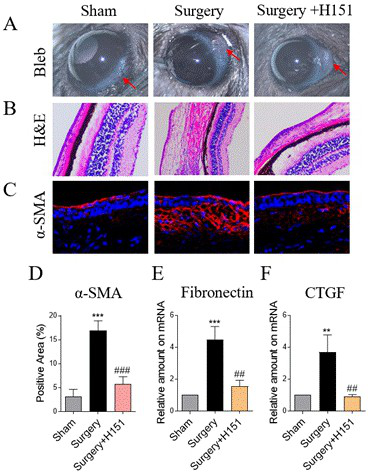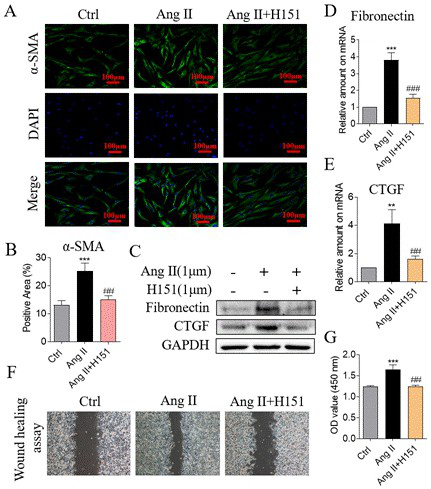Application of STING inhibitor in preparation of anti-filtration channel conjunctival cicatrization treatment medicine
A technology of 1. STING and 8. STING, applied in the preparation of anti-filtration tract conjunctival scarring treatment drugs, in the field of STING inhibitors, to relieve filtration tract conjunctival sac fibrosis and filtration tract scarring, and improve the efficiency of the invention. Effect
- Summary
- Abstract
- Description
- Claims
- Application Information
AI Technical Summary
Problems solved by technology
Method used
Image
Examples
Embodiment 1
[0021] Successfully established a scarring model of the filtering tract after trabeculectomy. The surgical method of trabeculectomy in mice refers to previous literature reports (Invest Ophthalmol Vis Sci. 2017, 58(9):3432-3439). After the operation, STING was injected into the conjunctival sac The specific small molecule inhibitor H151 was treated for 2 weeks, and 2 weeks after the operation, the mice were photographed under the operating microscope after anesthesia to observe the conjunctival filtering blebs of the mice.
[0022] Test procedure: Male C57BL / 6 mice were purchased from a commercial animal experiment center. Mice were housed in a thermostated 12-12h diurnal animal room with standard rodent chow and water. Animals were acclimatized to the environment one week before the start of the experiment. The H151 used in the experiment is a DMSO-soluble dosage form with a final concentration of 1 mg / kg. A mouse model of trabeculectomy with scarring of the filtering tract...
Embodiment 2
[0025] HTF cells were pre-incubated with H151 for 1 h, then stimulated with Ang II (1 μM) for 6 or 24 hours, and the effects of H151 on anti-Ang II were detected by fluorescent staining, quantitative fluorescence, RT-qPCR, Western Blot, and scratch experiments, respectively. .
[0026] Test procedure: HTF cells were pre-incubated with H151 (final concentration 1 μg / ml) for 1 hour, and stimulated with Ang II (1 μM) for 6 or 24 hours. (A, B) Immunofluorescence detection of αSMA expression level in trabeculectomy filtration channel of mice; (C) Western Blot detection of protein levels of Fibronectin and CTGF; (D, E) Real time qPCR detection of mRNA levels of Fibronectin and CTGF; ( F) Migration scratch test was used to detect the migration ability of HTF cells; (G) CCK8 was used to detect the cell proliferation ability. ** p < 0.01, *** p < 0.001, Ctrl vs Ang II; ## p < 0.01, ### p < 0.001, Ang II vs Ang II + H151.
[0027] Such as figure 2 As shown in A and B, it can be foun...
PUM
 Login to View More
Login to View More Abstract
Description
Claims
Application Information
 Login to View More
Login to View More - R&D
- Intellectual Property
- Life Sciences
- Materials
- Tech Scout
- Unparalleled Data Quality
- Higher Quality Content
- 60% Fewer Hallucinations
Browse by: Latest US Patents, China's latest patents, Technical Efficacy Thesaurus, Application Domain, Technology Topic, Popular Technical Reports.
© 2025 PatSnap. All rights reserved.Legal|Privacy policy|Modern Slavery Act Transparency Statement|Sitemap|About US| Contact US: help@patsnap.com



